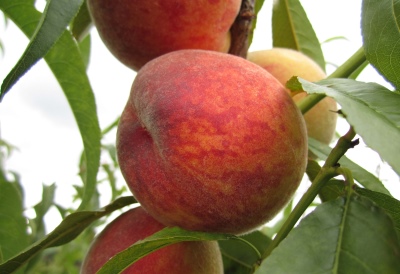
- Growth type: vigorous
- Appointment: for fresh consumption
- Yield: high
- Marketability: high
- Winter hardiness: good
- Fruit weight, g: 100-160
- Fruit color: golden yellow with a large bright red blush
- Fruiting period: first half of July
- Average yield: 55-60 kg / wood
- Frequency of fruiting: regular
It became possible to grow a peach in a summer cottage thanks to the efforts of breeders who develop varieties that are resistant to unfavorable climatic conditions. One of the tasty and not capricious to care for is the Boxer variety, which is famous for its large fruits.
Description of the variety
The Boxer is a vigorous tree with a wide, rounded crown, characterized by strong branching and moderate thickening. Leaves drooping emerald green. The peculiarities of the fruit tree are its rapid growth and green mass gain. In a favorable environment, the tree grows up to 4–6 m in height.
The peach tree begins to bloom at the end of April. At this time, the voluminous crown is abundantly covered with medium goblet pink flowers, emitting an incredible aroma.
Fruit characteristics
The peach variety of folk selection Boxer is a large-fruited variety. An adult tree grows fruits weighing 100–160 g. The larger the fruits, the less of them on the tree. The peach has an oval shape and a beautiful color: a golden yellow cover, diluted with a fuzzy bright red blush in the form of stripes, dots, specks that cover most of the fruit. Fruit skin is moderately firm and velvety. The abdominal suture is clearly defined.
Although peaches are intended for fresh consumption, they are canned, pickled, processed into jams, compotes, and preserves. The strong skin of the fruit allows you to transport peaches over long distances, as well as store them in proper conditions for up to 5-7 days. The softening of the fruit is slow.
Taste qualities
The boxer is famous for its excellent taste and marketability. The orange-yellow flesh is characterized by a fleshy, medium-fiber, tender, moderately dense and very juicy texture. The fruit has a balanced taste: sweet, diluted with a refreshing subtle sourness. The summer and bright aroma that peaches are endowed with does not disappear even after canning or processing. The peel of the fruit is not bitter. The small pit is easily separated from the peach pulp.
Ripening and fruiting
The tree begins to bear fruit 2-3 years after planting. Fruiting of the variety is stable annually. A variety of medium early ripening. Fruits begin to sing massively by mid-July. The fruiting period lasts up to 3 weeks. Despite the large size, ripe peaches do not crumble.
Yield
The yield figures for the peach crop are impressive. Providing the tree with basic agricultural techniques, an excellent harvest can be obtained per season: 55–60 kg of aromatic fruits.
Self-fertility and the need for pollinators
The variety is self-fertile, therefore, the tree does not need additional cross-pollination, especially since during the flowering period the tree is a real paradise for insects.
Growing and care
Planting peach seedlings can be carried out both in the spring (before the beginning of the growing season) and in the fall (3-4 weeks before frost). It is recommended to choose one / two-year-old seedlings with a developed root system.When planting, it is important to maintain a distance of 3-4 m between trees, since the peach does not like shade. The agrotechnics of the peach tree is simple, but requires the mandatory implementation of measures: watering, fertilizing, forming a crown, removing dry and damaged branches, loosening and weeding the soil, preventing fungi, mulching and preparing for cold weather.



Frost resistance and the need for shelter
The boxer is not afraid of temperature drops down to -25-28 °, since he has high frost resistance. It is also worth noting that flower buds are not afraid of temperature fluctuations. The peach tree does not need shelter, but in severe frost conditions, it is recommended to carry out shelters using burlap or agrofibre. In addition, the periosteal circle is mulched with humus, which will protect the root system from freezing.
Disease and pest resistance
The boxer has a good immune defense, due to which the tree is able to withstand most of the standard diseases of peach crops. Timely preventive spraying with insecticidal preparations will help prevent the invasion of pests.

Requirements for soil and climatic conditions
Peach Boxer is a heat-loving culture that needs a lot of light, heat, sun, so it is comfortable to grow a tree in the southern part of the garden. The tree has no special requirements for the soil, however, it is most favorable for the peach to develop and bear fruit on loose, breathable, nutritious moist soils with a neutral level of acidity.
































































